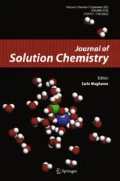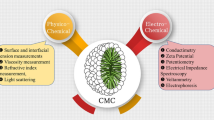Abstract
Micellization of the cationic surfactant cetyltrimethylammonium bromide (CTAB) in dilute aqueous solutions of sodium butyrate (Na-Bu), sodium benzoate (Na-Ben) and sodium salicylate (Na-Sal) at different concentrations, viz. 0.005, 0.01, and 0.05 mol·L−1, has been investigated. Conductivity, steady-state fluorescence, dynamic light scattering (DLS), atomic force microscopy (AFM), and 1H NMR techniques shed light on different aspects of micellization. Various micellization parameters such as critical micelle concentration (cmc), degree of ionization of micelle (α), and standard Gibbs energy of micellization (\( \Delta G_{\text{m}}^{\text{o}} \)) have been obtained from conductivity measurements. Steady-state fluorescence has provided useful information about the cmc, polarity of cybotactic region and aggregation number of micelles of CTAB using pyrene as fluorescent probe in various aqueous salt solutions. The data have been analyzed in terms of hydrophobicity/hydrophilicity and polarizability of the anions of the added electrolytes. The content and nature of organic anions governs the shape and size of the micelles as revealed by DLS and AFM measurements. In the dilute concentration regime of added electrolytes, contrary to most of the reported studies pertaining to very high concentration of added electrolyte, no worm like micelles forming a gel like structure have been observed. 1H NMR experiments provided information about the sites of interaction of anions of added electrolytes with the surfactant head group.
Graphical abstract











Similar content being viewed by others
References
Bergström, M.: Derivation of size distributions of surfactant micelles taking into account shape, composition, and chain packing density fluctuations. J. Coll. Interface Sci. 181, 208–219 (1996)
Romsted, L.S.: Do amphiphile aggregate morphologies and interfacial compositions depend primarily on interfacial hydration and ion-specific interactions? The evidence from chemical trapping. Langmuir 23, 414–424 (2007)
Sein, A., Engberts, J.B.F.N.: Micelle to lamellar aggregate transition of an anionic surfactant in dilute aqueous solution induced by alkali metal chloride and tetraalkylammonium chloride salts. Langmuir 11, 455–465 (1995)
Liu, S., González, Y.I., Kaler, E.W.: Structural fixation of spontaneous vesicles in aqueous mixtures of polymerizable anionic and cationic surfactants. Langmuir 19, 10732–10738 (2003)
Jurašin, D., Vinceković, M., Pustak, A., Šmit, I., Bujan, M., Filipović-Vinceković, N.: Lamellar to hexagonal columnar liquid crystalline phase transition in a catanionic surfactant mixture: dodecylammonium chloride–sodium bis(2-ethylhexyl) sulfosuccinate. Soft Matt. 9, 3349–3360 (2013)
Singh, K., Dharaiya, N., Marangoni, D.G., Bahadur, P.: Dissimilar effects of solubilized p-toluidine on the shape of micelles of differently charged surfactants. Colloids Surf. A 436, 521–529 (2013)
Bijma, K., Engberts, J.B.F.N.: Effect of counterions on properties of micelles formed by alkylpyridinium surfactants. 1. Conductometry and 1H-NMR chemical shifts. Langmuir 13, 4843–4849 (1997)
Nan, Y.Q., Hao, L.S.: Salt-induced phase inversion in aqueous cationic/anionic surfactant two-phase systems. J. Phys. Chem. B 112, 12326–12337 (2008)
Maiti, K., Mitra, D., Guha, S., Moulik, S.P.: Salt effect on self-aggregation of sodium dodecylsulfate (SDS) and tetradecyltrimethylammonium bromide (TTAB): physicochemical correlation and assessment in the light of Hofmeister (lyotropic) effect. J. Mol. Liq. 146, 44–51 (2009)
Kang, K.H., Kim, H.U., Lim, K.H.: Effect of temperature on critical micelle concentration and thermodynamic potentials of micellization of anionic ammonium dodecyl sulfate and cationic octadecyltrimethyl ammonium chloride. Colloids Surf. A 189, 113–121 (2001)
Benrraou, M., Bales, B.L., Zana, R.: Effect of the nature of the counterion on the properties of anionic surfactants. 1. cmc, ionization degree at the cmc and aggregation number of micelles of sodium, cesium, tetramethylammonium, tetraethylammonium, tetrapropylammonium, and tetrabutylammonium dodecyl sulfates. J. Phys. Chem. B 107, 13432–13440 (2003)
Zana, R., Benrraou, M., Bales, B.L.: Effect of the nature of the counterion on the properties of anionic surfactants. 3, Self-association behavior of tetrabutylammonium dodecylsulfate and tetradecyl sulfate: clouding and micellar growth. J. Phys. Chem. B 108, 18195–18203 (2004)
Renoncourt, A., Vlachy, N., Bauduin, P., Drechsler, M., Touraud, D., Verbavatz, J.M., Dubois, M., Kunz, W., Ninham, B.W.: Specific alkali cation effects in the transition from micelles to vesicles through salt addition. Langmuir 23, 2376–2381 (2007)
Ali, M., Jha, M., Das, S.K., Saha, S.K.: Hydrogen-bond-induced microstructural transition of ionic micelles in the presence of neutral naphthols: pH dependent morphology and location of surface activity. J. Phys. Chem. B 113, 15563–15571 (2009)
Clausen, T.M., Vinson, P.K., Minter, J.R., Davis, H.T., Talmon, Y., Miller, W.G.: Viscoelastic micellar solutions: microscopy and rheology. J. Phys. Chem. 96, 474–484 (1992)
Lin, Z., Cai, J.J., Scriven, L.E., Davis, H.T.: Spherical-to-wormlike micelle transition in CTAB solutions. J. Phys. Chem. 98, 5984–5993 (1994)
Laisen, J.W., Tepley, L.B.: Interactions of some aromatic salts with hexadecyltrimethylammonium bromide micelles. Viscosity, counterion binding, and calorimetric observations. J. Org. Chem. 41, 2968–2970 (1976)
Bachofer, S.J., Simonis, U., Nowicki, T.A.: Orientational binding of substituted naphthoate counterions to the tetradecyltrimethylammonium bromide micellar interface. J. Phys. Chem. 95, 480–488 (1991)
Nemoto, N., Kuwahara, M.: Dynamic light scattering of CTAB/sodium salicylate long threadlike micelles in the semidilute regime: applicability of the dynamic scaling law. Langmuir 9, 419–423 (1993)
Kim, W.J., Yang, S.M.: Microstructures and rheological responses of aqueous CTAB solutions in the presence of benzyl additives. Langmuir 16, 6084–6093 (2000)
Aswal, V.K.: Effect of the hydrophilicity of aromatic counterions on the structure of ionic micelles. J. Phys. Chem. B 107, 13323–13328 (2003)
Kumar, S., David, S.L., Aswal, V.K., Goyal, P.S.: Kabir-ud-Din: Growth of sodium dodecylsulfate micelles in aqueous ammonium salts. Langmuir 13, 6461–6464 (1997)
Mukhim, T., Dey, J., Das, S., Ismail, K.: Aggregation and adsorption behavior of cetylpyridinium chloride in aqueous sodium salicylate and sodium benzoate solutions. J. Coll. Interface Sci. 350, 511–515 (2010)
Shikata, T., Hirata, H., Kotaka, T.: Micelle formation of detergent molecules in aqueous media. 2. Role of free salicylate ions on viscoelastic properties of aqueous cetyltrimethylammonium bromide–sodium salicylate solutions. Langmuir 4, 354–359 (1988)
Bachofer, S.J., Turbitt, R.M.: The orientational binding of substituted benzoate anions at the cetyltrimethylammonium bromide interface. J. Coll. Interface Sci. 135, 325–334 (1990)
Sinha, S., Dogra, A., Jain, N.J., Bahadur, P.: Effect of organic counter-ions on the surface activity, micellar formation and solubilizing behaviour of a cationic surfactant. Indian J. Chem. 37A, 118–124 (1998)
Roy, B.K., Moulik, S.P.: Energetic, surface-chemical and hydrodynamic studies on cetyltrimethylammonium bromide and sodium salicylate. Indian J. Chem. 38A, 17–25 (1999)
Bachofer, S.J., Simonis, U.: Determination of the ion exchange constants of four aromatic organic anions competing for a cationic micellar interface. Langmuir 12, 1744–1754 (1996)
Oelschlaeger, C., Suwita, P., Willenbacher, N.: Effect of counterion binding efficiency on structure and dynamics of worm like micelles. Langmuir 26, 7043–7053 (2010)
Takeda, M., Kusano, T., Matsunaga, T., Endo, H., Shibayama, M., Shikata, T.: Rheo-SANS studies on shear-thickening/thinning in aqueous rod like micellar solutions. Langmuir 27, 1731–1738 (2011)
Das, N.C., Cao, H., Kaiser, H., Warren, G.T., Gladden, J.R., Sokol, P.E.: Shape and size of highly concentrated micelles in CTAB/NaSal solutions by small angle neutron scattering (SANS). Langmuir 28, 11962–11968 (2012)
Naskar, B., Dan, A., Ghosh, S., Aswal, V.K., Moulik, S.P.: Revisiting the self-aggregation behavior of cetyltrimethylammonium bromide in aqueous sodium salt solutions with varied anions. J. Mol. Liquids 170, 1–10 (2012)
Wang, Z., Larson, R.G.: Molecular dynamics simulations of thread like cetyltrimethylammonium chloride micelles: effects of sodium chloride and sodium salicylate salts. J. Phys. Chem. B 113, 13697–13710 (2009)
Francisco, K.R., da Silva, M.A., Sabadini, E., Karlsson, G., Dreiss, C.A.: Effect of monomeric and polymeric co-solutes on cetyltrimethylammonium bromide wormlike micelles: rheology, Cryo-TEM and Small-angle neutron scattering. J. Colloid Interface Sci. 345, 351–359 (2010)
Pei, X., Zhao, J., Wei, X.: Comparative study of the viscoelastic wormlike micellar solutions of hexanediyl-α,ω-bis(dimethylcetylammonium bromide) and cetyltrimethylammonium bromide in the presence of sodium salicylate. Colloids Surf. A 366, 203–207 (2010)
Vermathen, M., Stiles, P., Bachofer, S.J., Simonis, U.: Investigations of monofluoro-substituted benzoates at the tetradecyltrimethylammonium micellar interface. Langmuir 18, 1030–1042 (2002)
Abezgauz, L., Kuperkar, K., Hassan, P.A., Ramon, O., Bahadur, P., Danino, D.: Effect of Hofmeister anions on micellization and micellar growth of the surfactant cetylpyridinium chloride. J. Colloid Interface Sci. 342, 83–92 (2010)
Ramanathan, M., Shrestha, L.K., Mori, T., Ji, Q., Hill, J.P., Ariga, K.: Amphiphile nanoarchitectonics from basic physical chemistry to advanced applications. Phys. Chem. Chem. Phys. 15, 10580–10611 (2013)
Murphy, C.J., Jana, N.R.: Controlling the aspect ratio of inorganic nanorods and nanowires. Adv. Mater. 14, 80–82 (2002)
Gao, J., Bender, C.M., Murphy, C.J.: Dependence of the gold nanorod aspect ratio on the nature of the directing surfactant in aqueous solution. Langmuir 19, 9065–9070 (2003)
Blankschtein, D., Yuet, P.K.: Effect of surfactant tail-length asymmetry on the formation of mixed surfactant vesicles. Langmuir 12, 3819–3827 (1996)
Jacques, K.: Effects of sodium butyrate, a new pharmacological agent, on cells in culture. Mol. Cell. Biochem. 42, 65–82 (1981)
Krebs, H.A., Wiggins, D.M., Sols, S.A., Bedoya, F.: Studies on the mechanism of the antifungal action of benzoate. Biochem. J. 214, 657–663 (1983)
Lidija, K., Cammenga, J., Wisniewski, H.G., Nimer, S.D.: Sodium salicylate activates caspases and induces apoptosis of myeloid leukemia cell lines. Blood 93, 2386–2394 (1999)
Koga, Y., Nishikawa, K., Westh, P.: “Icebergs” or no “icebergs” in aqueous alcohols? Composition-dependent mixing schemes. J. Phys. Chem. A 108, 3873–3877 (2004)
Rakitin, A.R., Pack, G.R.: Necessity of aromatic carboxylate anions to be planar to induce growth of cationic micelles. Langmuir 21, 837–840 (2005)
Kalyanasundaram, K., Thomas, J.K.: Environmental effects on vibronic band intensities in pyrene monomer fluorescence and their application in studies of micellar systems. J. Am. Chem. Soc. 99, 2039–2044 (1977)
Aguiar, J., Carpena, P., Molina-Bolívar, J.A., Ruiz, C.C.: On the determination of the critical micelle concentration by the pyrene 1:3 ratio method. J. Colloid Interface Sci. 258, 116–122 (2003)
Kalyanasundaram, K.: Photochemistry in Microheterogeneous Systems. Academic Press, San Diego (1987)
Bohren, C.F., Huffman, D.R.: Absorption and Scattering of Light by Small Particles, p. 530. Wiley, New York (1983)
Movchan, T.G., Soboleva, I.V., Plotnikova, E.V., Shchekin, A.K., Rusanov, A.I.: Dynamic light scattering study of cetyltrimethylammoniumbromide aqueous solutions. Colloid J. 74, 239–247 (2012)
Dorshow, R., Briggs, J., Bunton, C.A., Nicoli, D.F.: Dynamic light scattering from cetyltrimethylammonium bromide micelles. Intermicellar interactions at low ionic strengths. J. Phys. Chem. 86, 2388–2395 (1982)
Alargova, R., Petkov, J., Petsev, D., Ivanov, I.B., Broze, G., Mehreteab, A.: Light scattering study of sodium dodecyl polyoxyethylene-2-sulfatemicelles in the presence of multivalent counterions. Langmuir 11, 1530–1536 (1995)
Raghavan, S.R., Kaler, E.W.: Highly viscoelastic wormlike micellar solutions formed by cationic surfactants with long unsaturated tails. Langmuir 17, 300–306 (2001)
Singh, T., Kumar, A.: Aggregation behavior of ionic liquids in aqueous solutions: effect of alkyl chain length, cations, and anions. J. Phys. Chem. B 111, 7843–7851 (2007)
Davey, T.W., Ducker, W.A., Hayman, A.R.: Aggregation of ω-hydroxy quaternary ammonium bolaform surfactants. Langmuir 16, 2430–2435 (2000)
Lemyre, J.L., Ritcey, A.M.: Characterization of a reverse micellar system by 1H-NMR. Langmuir 26, 6250–6255 (2010)
Vigderman, L., Manna, P., Zubarev, E.R.: Quantitative replacement of cetyltrimethylammonium bromide by cationic thiol ligands on the surface of gold nanorods and their extremely large uptake by cancer cells. Angew. Chem. Int. Ed. 51, 636–641 (2012)
Tonelli, A.E.: NMR Spectroscopy and Polymer Microstructure: The Conformational Connection. VCH, New York (1989)
Taboada, P., Attwood, D., Ruso, J.M., Sarmiento, F., Mosquera, V.: Self-association of amphiphilic penicillins in aqueous electrolyte solution: a light-scattering and NMR study. Langmuir 15, 2022–2028 (1999)
Nagamura, T., Mihara, S., Okahata, Y., Kunitake, T., Matsuo, T.: NMR and fluorescence studies on self-assembling behaviour of dialkyldimethylammoinum salts in aqueous solutions. Ber. Bunsen-Ges. 82, 1093–1098 (1978)
Bloembergen, N., Purcell, E.M., Pound, R.V.: Relaxation effects in nuclear magnetic resonance absorption. Phys. Rev. 73, 679–712 (1948)
Kreke, P.J., Magid, L.J., Gee, J.C.: 1H and 13C NMR studies of mixed counterion, cetyltrimethylammonium bromide/cetyltrimethylammoniumdichlorobenzoate, surfactant solutions: the intercalation of aromatic counterions. Langmuir 12, 699–705 (1996)
Acknowledgments
Financial assistance by UGC, Government of India wide project number F. 20-24(12)/2012(BSR) is highly acknowledged.
Author information
Authors and Affiliations
Corresponding author
Electronic supplementary material
Below is the link to the electronic supplementary material.
Rights and permissions
About this article
Cite this article
Bharmoria, P., Vaneet, Banipal, P.K. et al. Modulation of Micellization Behavior of Cetyltrimethylammonium Bromide (CTAB) by Organic Anions in Low Concentration Regime. J Solution Chem 44, 16–33 (2015). https://doi.org/10.1007/s10953-014-0271-3
Received:
Accepted:
Published:
Issue Date:
DOI: https://doi.org/10.1007/s10953-014-0271-3




